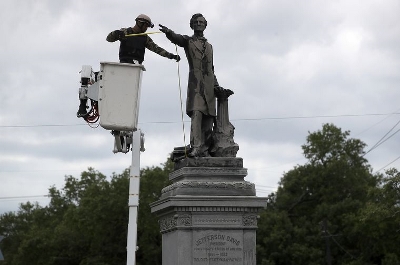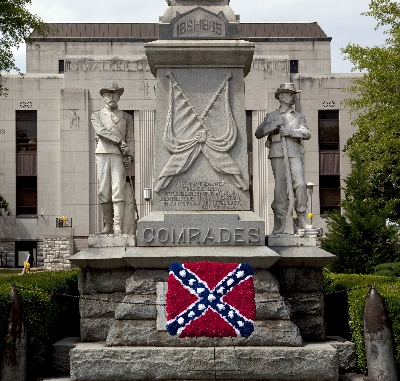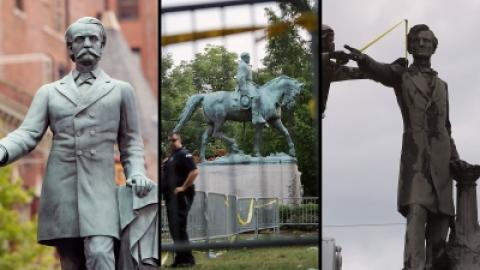- These are the Dozens of Movements Underway to Remove Confederate Monuments. Help Identify More - Will Drabold (Mic)
- List of Monuments and Memorials of the Confederate States of America - Wikipedia, Revised and Updated: August 15, 2017
These are the Dozens of Movements Underway to Remove Confederate Monuments. Help Identify More
By Will Drabold
August 14, 2017
Monuments to Confederate soldiers and generals hold prominent positions in dozens of cities across the southern United States. Over the weekend, one of them — a statue of Confederate leader Robert E. Lee in Charlottesville, Virginia — became the site of a violent clash between white supremacists and anti-racist counter-protesters.
The movement to remove such monuments has picked up steam after a white supremacist killed nine people at a Charleston, South Carolina, church in June 2015. The Confederate battle flag, which flew on the grounds of the state’s capitol in Columbia, was lowered following the shooting.
So far, Mic has identified 35 movements in 2017 that have removed or are pushing to remove specific Confederate monuments. Many of these efforts began or were renewed in the days since the violence in Charlottesville. That includes online petitions, in-person protests, moves by city officials and other efforts to remove memorials.
At least thirteen Confederate monuments have been removed from public land in 2017 alone (a fourteenth was relocated from public land in one Kentucky city to another). Seven of those removals have occurred since the violence in Charlottesville.
Mic has verified more than 140 Confederate monuments across 17 states that are on public land, often in proximity to county courthouses or in city parks. A number of national movements have emerged calling for the removal of all Confederate monuments, but this list is more focused on local efforts specific to certain monuments.
In 2016, the Southern Poverty Law Center identified more than 1,500 Confederate symbols in public places, including at least 700 on public property. Five southern states have more than 100 public symbols. Virginia has more than 200.

Thanks to the Mic readers who helped us crowdsource the information on this spreadsheet. We’re still accepting your help to track the nationwide movements to remove Confederate monuments. Know of one? Reach out through this form. Keep reading to see the movements we are tracking, and learn more about the effort at the bottom of this article.
Here are the movements to remove Confederate monuments nationwide:
Alabama
Birmingham: The city covered up a Confederate monument as it debates whether to remove the memorial permanently.
Arizona
Statewide: There have been calls to remove Confederate monuments from state property, but Gov. Doug Ducey, a Republican, has rejected those proposals.
California
San Diego: A group started a petition to remove a plaque memorializing Jefferson Davis in Horton Park. The plaque was removed on Wednesday, Aug. 16 by the city of San Diego. The plaque was the only known Confederate monument on public property in California. That excludes streets and schools named after Confederate leaders.
District of Columbia
Washington: A statue of Albert Pike stands in Judiciary Square. It is the only outdoor statue of a Confederate officer in the nation’s capital.
Florida
Fort Myers: The local NAACP chapter is pushing to remove a portrait of Gen. Robert E. Lee in the city council chamber.
Gainesville: A Confederate statue known as “Old Joe” was removed by the city on Aug. 14.
Jacksonville: The city council president has called for the removal of Confederate monuments.
Tampa: The city commission voted to move a Confederate monument before the Charlottesville violence. As of Tuesday, the statue is still there.
Georgia
Decatur: A local petition is pushing for the removal of a Confederate monument.
Stone Mountain: Stacey Abrams, a Democratic candidate for Georgia governor, called for the removal of a carving of Confederate generals at a state-owned park. It requires an act of the legislature to remove the carving created in 1915 by leaders of the Ku Klux Klan.
Kentucky
Lexington: The mayor and local activists are pushing to remove two statues.
Louisville: A Confederate monument was relocated to Brandenburg, Kentucky, earlier this year.
Louisiana
New Orleans: Four monuments were removed and put in a warehouse in 2017 before the Charlottesville violence.
Shreveport: An online petition to remove the Confederate monument outside the Caddo County Courthouse has nearly 6,000 signatures.
Lafayette: Local residents are still pushing for the removal of the statue of a Confederate general. The parish council passed on moving the statue last year.
Maryland
Annapolis: Democratic and progressive leaders are calling for the removal of the statue of a Confederate leader on the state Capitol grounds.
Baltimore: The city removed four Confederate monuments early in the morning on Wednesday, August 16.
Ellicott City: County leaders are discussing removing a Confederate monument.
Rockville: A Confederate monument was removed in late July.
Salisbury: An online petition and the city’s mayor are calling for the removal of a plaque commemorating the Confederacy.
Missouri
St. Louis: A Confederate monument in a city park was removed in 2017 before the Charlottesville violence.
North Carolina
Statewide: Gov. Roy Cooper (D-N.C.) called for the removal of all Confederate monuments on Tuesday, Aug. 15.
Asheville: Protesters called for the removal of a Confederate statue on Aug. 13.
Chapel Hill: The statue of a Confederate soldier on the campus of the University of North Carolina at Chapel Hill has long faced calls for removal.
Durham: A Confederate monument in Durham, North Carolina, was torn down by demonstrators on Monday, Aug. 14.
Greenville: A public petition is calling for the removal of a Confederate monument outside the county courthouse.
Tennessee
Chattanooga: The NAACP chapter asked for the removal of the statue of a Confederate general in July.
Memphis: The city of Memphis is trying to convince a state agency to let it remove two Confederate statues on public land.
Nashville: Protesters demanded the removal of a bust of Nathan Bedford Forrest, the founder of the Ku Klux Klan, in the state Capitol.
Texas
Austin: A rally is planned for early September to support the preservation of a Confederate monument near the state capitol. A larger, counter-protest is also planned.
Dallas: A day before the event in Charlottesville began, protesters in Dallas called for the removal of a Confederate monument.
Houston: Petitioners want a Spirit of the Confederacy monument removed from Sam Houston park.
San Antonio: A crowd called for the removal of a Confederate statue following the violence in Charlottesville.
Virginia
Charlottesville: The Robert E. Lee statue in Emancipation Park was the site of the “Unite the Right” rally that drew hundreds of far-right protesters demonstrating against the monument’s planned removal and resulted in the death of one counter-protester.
Richmond: Protesters demanded the removal of several statues of Confederate leaders on Monday, Aug. 14. The mayor has continued to call for updating the statutes to clarify what they represent, not removing them.
West Virginia
Charleston: Protesters called for the removal of a statue of Stonewall Jackson on the state Capitol grounds.
Help us track movements to remove Confederate monuments
Mic wants to keep track of emerging movements to remove Confederate monuments across the country. This is where you come in.
We have created a spreadsheet of monuments we believe, based on public information online, to be located on public land. You can view that spreadsheet here.
Are we missing any Confederate monuments on public land? Are you aware of any monuments on the list that have been removed? Do you know of any movements to remove any of the listed monuments?
If so, please fill out this form to get in touch with our journalists or email Mic reporter Will Drabold at wdrabold@mic.com. We will verify information submitted to Mic and regularly update this story.
[Will Drabold is a policy writer at Mic. He writes Navigating Trump's America, Mic's daily read on Donald Trump's America. He is based in Washington, D.C., and can be reached at wdrabold@mic.com]
List of monuments and memorials of the Confederate States of America
From Wikipedia, the free encyclopedia
Revised and Updated: August 15, 2017

This is a list of Confederate monuments and memorials. The monuments and memorials honor Confederate leaders, soldiers, or the Confederate States of America in general during the American Civil War. A 2017 study reported that at least 1,503 symbols of the Confederacy can be found in public spaces across the country, including physical monuments and memorials as covered in this list, but also including other symbols such as schools named after Confederate leaders, along with Jefferson Davis Community College (Alabama), Lee College (Texas), and Washington and Lee University (Virginia). Four counties are named for Jefferson Davis (Georgia, Louisiana, Mississippi, Texas), nine for Robert E. Lee (Alabama, Arkansas, Florida, Georgia, Kentucky, Mississippi, North Carolina, South Carolina, Texas), and two for Stonewall Jackson (Oklahoma, Texas. Many of these monuments were erected in the early 20th century, decades after the Civil War, and have some relationship with campaigns to promote and justify Jim Crow laws in the South.
Art historians Cynthia Mills and Pamela Simpson noted in their critical volume Monuments to the Lost Cause that the majority of Confederate monuments were "commissioned by white women, in hope of preserving a positive vision of antebellum life.” Many Confederate monuments were erected in the former Confederate states and border states in the decades following the Civil War, in many instances by the United Daughters of the Confederacy, Ladies Memorial Associations, and other memorial organizations. Other Confederate monuments are located on Civil War battlefields. Many Confederate monuments are listed on the National Register of Historic Places, either separately or as contributing objects within listings of courthouses or historic districts.
Confederate monuments, as well as parks, schools, roads, and other places are listed here alphabetically by state, and by city within each state:
Alabama
There are at least 107 publicly-supported spaces dedicated to the Confederacy in Alabama.
Arizona
There are at least 3 publicly-supported spaces dedicated to the Confederacy in Arizona.
Arkansas
There are at least 57 publicly-supported spaces dedicated to the Confederacy in Arkansas.
California
There are at least 4 remaining publicly-supported spaces dedicated to the Confederacy in California and 3 former spaces; at least 6 roads; and at least 2 schools.
Delaware
In Georgetown: Delaware Confederate Monument, unveiled in 2007.
Florida
There are at least 61 publicly-supported spaces dedicated to the Confederacy in Florida.
Georgia
There are at least 174 publicly-supported spaces dedicated to the Confederacy in Georgia.
Idaho
There are at least 2 publicly-supported spaces dedicated to the Confederacy in Idaho, in Boise.
Illinois
There are at least 2 public monuments dedicated to the Confederacy in Illinois, in Alton and Chicago.[108, 109]
Indiana
There are at least 4 publicly-supported spaces dedicated to the Confederacy in Indiana, in Corydom, Indianapolis and Terre Haute[1, 110]
Iowa
There are at least 3 publicly-supported spaces dedicated to the Confederacy in Iowa, in Betonsport and Bloomfield.
Kansas
There is at least one publicly-supported site dedicated to the Confederacy in Kansas, in Humboldt; one in Wichita was removed in 2015.[1, 111, 112]
Kentucky
There are at least 56 publicly-supported spaces dedicated to the Confederacy in Kentucky.
Louisiana
There are at least 91 publicly-supported spaces dedicated to the Confederacy in Louisiana.. In New Orleans, after nine black churchgoers were killed in a racially-motivated massacre in Charleston, S.C., the New Orleans City Council ordered the removal of statues of Confederate President Jefferson Davis; General Robert E. Lee, who resigned his U.S Army commission at the time of Virginia's secession and accepted command of the state's military forces; General Pierre G.T. Beauregard, who oversaw the Battle of Fort Sumter; and the Battle of Liberty Place Monument. Court challenges were unsuccessful. The workers who moved the monuments were dressed in bullet-proof vests, helmets, and masks to conceal their identities because of concerns about their safety. According to Mayor Landrieu, "The original firm we’d hired to remove the monuments backed out after receiving death threats and having one of his cars set ablaze."
Maryland
There are at least 3 publicly-supported spaces dedicated to the Confederacy in Maryland, in Annapolis, Easton, Ellicot City and Rockville. Four monuments in Baltimore were removed August 16, 2017[1, 124, 125, 126]
Massachusetts
There is 1 publicly-supported space dedicated to the Confederacy in Massachusetts, in Boston harbor, first dedicated in 1963.[1, 127]
Mississippi
There are at least 131 publicly-supported spaces dedicated to the Confederacy in Mississippi.
Montana
There are at least 3 publicly-supported spaces dedicated to the Confederacy in Montana, in Beaverhead and Helena
Nevada
There is at least 1 publicly-supported space dedicated to the Confederacy in Nevada, in the Great Basin National Park[1, 136]
New York
There are at least 3 publicly-supported spaces dedicated to the Confederacy in New York, city streets in Bronx and Brooklyn
North Carolina
There are at least 140 publicly-supported spaces dedicated to the Confederacy in North Carolina.
Ohio
There are at least 3 publicly-supported spaces dedicated to the Confederacy in Ohio, in Columbus and Franklin, and public streets in Cincinnati
Oklahoma
There are at least 13 publicly-supported spaces dedicated to the Confederacy in Oklahoma, in Durant, Hugo, Oklahoma City, Pauls Valley, Rentiesville, Tahlequah, Tulsa and Wynnewood, (the one in Wynnewood first erected in 2004.[1, 147, 148, 149, 150, 151, 152, 153]
Pennsylvania
There are at least 4 publicly-supported spaces dedicated to the Confederacy in Pennsylvania, in Gettysburg and McConnellsburg, and road ins McConnellsburg and Wilkes-Barre[1, 154]
South Carolina
There are at least 112 publicly-supported spaces dedicated to the Confederacy in South Carolina.
Tennessee
There are at least 80 publicly-supported spaces dedicated to the Confederacy in Tennessee.
Texas
There are 178 publicly-supported spaces dedicated to the Confederacy in Texas.
Virginia
There are at least 223 publicly-supported spaces dedicated to the Confederacy in Virginia.
Washington
There is at least 1 publicly-supported space dedicated to the Confederacy in Washington, in East Wenatchee [1, 225]
Washington, D.C.
There are at least 2 publicly-supported spaces dedicated to the Confederacy in Washington, D.C.
West Virginia
There are at least 17 publicly-supported spaces dedicated to the Confederacy in West Virginia.
Wyoming
There are at least 2 publicly-supported spaces dedicated to the Confederacy in Wyoming, in Lakeview, and the one in Cheyenne, first dedicated in 2010.[1, 227, 228]
References
(full references can be found here. https://en.wikipedia.org/wiki/List_of_monuments_and_memorials_of_the_Confederate_States_of_America )
Specific references cites are:
1. Gunter, Booth; Kizzire, Jamie. Gunter, Booth, ed. "Whose heritage? Public Symbols of the Confederacy" (PDF). Southern Poverty Law Center. Retrieved 2017-08-15.
2. Dwyer, Colin (August 14, 2017). "Charlottesville Rally Aimed To Defend A Confederate Statue. It May Have Doomed Others". NPR.org. Retrieved 2017-08-15.
3. Bain, Marc (August 15, 2017). "The shoddy manufacturing story behind all those Confederate statues around the US". Quartz. Retrieved 2017-08-16.
4. Edwards, Stassa (August 15, 2017). "Confederate Monuments Aren't History, They're a Cheap Cultural Memory". Jezebel. Retrieved 2017-08-16.
5. Tennessee Encyclopedia of History and Culture
6. Wiggins, David N. (2006). Georgia's Confederate monuments and cemeteries. Charleston, SC: Arcadia. ISBN 9780738542331. OCLC 67612617.
7. Confederate Monument in Forsyth Park ArchivedMay 31, 2011, at the Wayback Machine., City of Savannah website, accessed April 24, 2010
8. United Daughters of the Confederacy Alabama Division (ALUDC), Encyclopedia of Alabama
9. Caroline E. Janney. "Ladies' Memorial Associations". Encyclopediavirginia.org. Retrieved May 23, 2017.
10. Caroline E. Janney. "Lost Cause, The". Encyclopediavirginia.org. Retrieved May 23, 2017.
11. National Park Service (2009-03-13). "National Register Information System". National Register of Historic Places. National Park Service.
108. Visitors Guide to the Confederate Prison Site & Confederate Memorials Alton, Illinois, Visitors Guide to the Middle Mississippi River Valley, accessed June 25, 2015
109. "Confederate Mound Oak Woods Cemetery--Civil War Era National Cemeteries: A Discover Our Shared Heritage Travel Itinerary". April 2, 2016. Archived from the original on April 2, 2016.
110. Ryckaert, Vic (2014-07-12). "Group wants to restore Confederate fighters’ monument". Indianapolis Star. Retrieved 2017-08-16.
111. http://www.humboldtkansas.org/civil_war_history.html
112. http://www.kansas.com/news/local/article43882719.html
117. Mele, Christopher (2017-04-24). "New Orleans Begins Removing Confederate Monuments, Under Police Guard". The New York Times. ISSN 0362-4331. Retrieved 2017-08-15.
118. Robertson, Campbell (2017-05-19). "From Lofty Perch, New Orleans Monument to Confederacy Comes Down". The New York Times. ISSN 0362-4331. Retrieved 2017-08-15.
119. Turque, Bill (2017-07-24). "Confederate statue moved from Rockville courthouse over the weekend". The Washington Post. ISSN 0190-8286. Retrieved 2017-08-15.
124. Grierson, Jamie (2017-08-16). "Baltimore takes down Confederate statues in middle of night". The Guardian. ISSN 0261-3077. Retrieved 2017-08-16.
125. Sun, Colin Campbell | Baltimore; Sun, Colin Campbell | Baltimore (2016-05-16). "As Confederate symbols come down, ‘Talbot Boys’ statue withstands the controversy". The Washington Post. ISSN 0190-8286. Retrieved 2017-08-15.
126. Turque, Bill; Turque, Bill (2017-07-24). "Confederate statue moved from Rockville courthouse over the weekend". The Washington Post. ISSN 0190-8286. Retrieved 2017-08-15.
127. Acitelli, Tom (2017-06-09). "Massachusetts’ only Confederate memorial likely to be taken down". Curbed Boston. Retrieved 2017-08-16.
147. Hampson, Rick (May 22, 2017). "Confederate monuments, more than 700 across USA, aren't budging". USA TODAY. Retrieved 2017-08-15.
148. "Confederate Soldiers Monument, Durant, Oklahoma". www.civilwaralbum.com . Retrieved 2017-08-15.
149. https://www.thelostogle.com/2017/08/16/4-confederate-monuments-in-oklahoma-that-should-be-torn-down/
150. http://newsok.com/article/5560216
151. http://newsok.com/article/5560216
152. http://newsok.com/article/5560216
153. http://newsok.com/article/5560216
154. Confederate Monuments at Gettysburg, StoneSentinels.com website, accessed April 24, 2010
161. http://www.co.waller.tx.us/upload/common/docs/Veterans/memorial_book.pdf . Retrieved 15 August 2017.
227. Shaw, Jerry (September 1, 2015). "Where You Can Find Confederate Flag Flying in Wyoming". Newsmax. Retrieved August 15, 2017.
228. Barron, Joan (September 5, 2010). "Wyoming pioneer John C. Hunton gets Confederate gravestone". The Billings Gazette. Retrieved August 15, 2017.


Spread the word